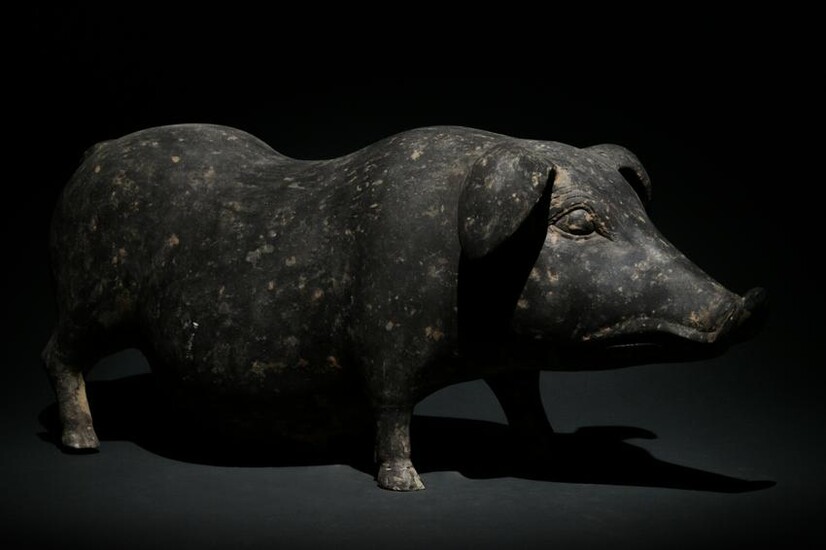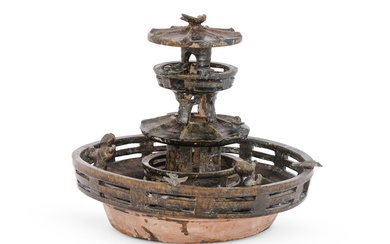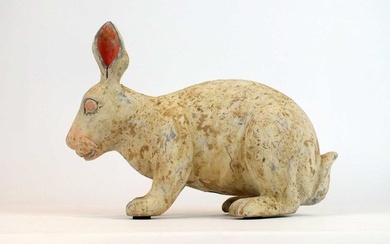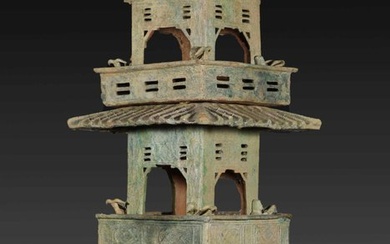CHINESE HAN DYNASTY TERRACOTTA BLACK PIG - TL TESTED
C. 206 BC - 220 AD. Han dynasty. A hollow-formed terracotta pig in a cream fabric with a painted black topcoat. The pig's features have been beautifully modelled and carefully incised detail is visible, especially around the eyes and snout. The pig, with an extremely prominent belly, is depicted in a neutral standing position, as if waiting - perhaps to be fed! The pig is the twelfth animal in the Chinese zodiac. According to traditional myth, the Jade Emperor said that the order of the animals in the zodiac would be decided by the order in which they arrived at his party. The pig was late because either because he overslept or because the wolf destroyed his house and he had to rebuild it before he could come to the party - traditions differ - but he was certainly the last animal to arrive and could only take the twelfth place. In Chinese culture, pigs are traditionally considered to be symbols of wealth, perhaps because of their chubby faces (and bellies) and their large prominent ears, which are viewed as symbols of wealth. The Han Dynasty, which ruled between 202 BC-220 AD, brought great prosperity and stability to China, reigning over a golden age of classical Chinese civilisation during which China saw major advances including the widespread development of a monetary economy and the invention of paper, as well as much progress in the decorative arts. This piece has been precisely dated having undergone Thermo Luminescence analysis by Ralf Kotalla, an independent German Laboratory. The samples collected date the piece to the period reflected in its style, whilst also showing no modern trace elements. Its TL certificate with full report will also accompany this lot. Provenance: Private London collection of Asian Art; formerly in an old British collection. Acquired in Hong Kong in the early 1990s. Size: L:200mm / W:530mm ; 7kg
[ translate ]View it on
Estimate
Time, Location
Auction House
C. 206 BC - 220 AD. Han dynasty. A hollow-formed terracotta pig in a cream fabric with a painted black topcoat. The pig's features have been beautifully modelled and carefully incised detail is visible, especially around the eyes and snout. The pig, with an extremely prominent belly, is depicted in a neutral standing position, as if waiting - perhaps to be fed! The pig is the twelfth animal in the Chinese zodiac. According to traditional myth, the Jade Emperor said that the order of the animals in the zodiac would be decided by the order in which they arrived at his party. The pig was late because either because he overslept or because the wolf destroyed his house and he had to rebuild it before he could come to the party - traditions differ - but he was certainly the last animal to arrive and could only take the twelfth place. In Chinese culture, pigs are traditionally considered to be symbols of wealth, perhaps because of their chubby faces (and bellies) and their large prominent ears, which are viewed as symbols of wealth. The Han Dynasty, which ruled between 202 BC-220 AD, brought great prosperity and stability to China, reigning over a golden age of classical Chinese civilisation during which China saw major advances including the widespread development of a monetary economy and the invention of paper, as well as much progress in the decorative arts. This piece has been precisely dated having undergone Thermo Luminescence analysis by Ralf Kotalla, an independent German Laboratory. The samples collected date the piece to the period reflected in its style, whilst also showing no modern trace elements. Its TL certificate with full report will also accompany this lot. Provenance: Private London collection of Asian Art; formerly in an old British collection. Acquired in Hong Kong in the early 1990s. Size: L:200mm / W:530mm ; 7kg
[ translate ]






